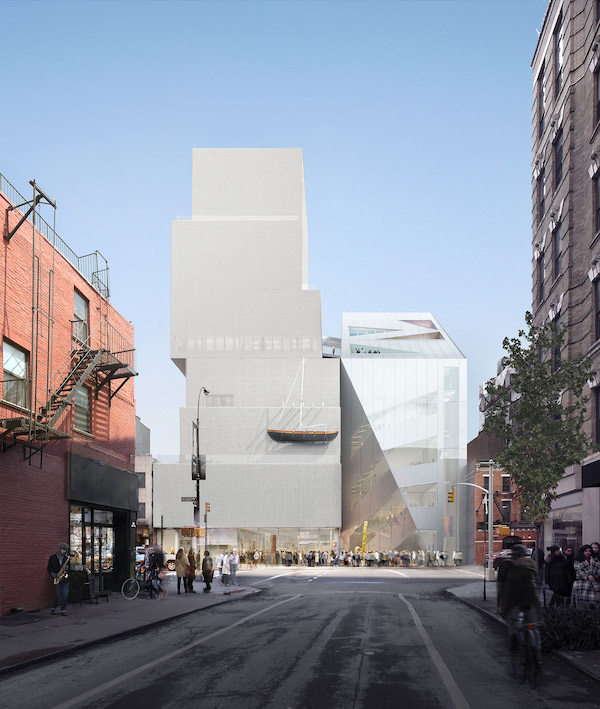Now twelve years old, SANAA’s New Museum building is still an enigmatic structure. When it opened in 2007, the vertical museum was taller by far than most everything else on that stretch of the Bowery on Manhattan’s Lower East Side—Norman Foster’s imposing Sperone Westwater Gallery (2010) a few doors down, and Herzog & de Meuron’s 28-story Public Hotel (2017) just behind it had not yet been built. The precariously stacked boxes of the museum, veiled in a mysterious metal skin, were an instant attraction. Perhaps too much so. Millions of visitors have come through its doors—annual attendance jumped from 60,000 to 400,000 with the SANAA building. But movement up the various levels of galleries is not always so easy.
If circulation was a major concern for an addition to the SANAA museum—the Pritzker Prize–winning Japanese firm's first free-standing structure in the U.S.—the form that new building would take was another. Would it compete with SANAA’s heap, or would it bow down in deference to it? The institution had acquired a 50,000-square-foot building at 231 Bowery just next door to its current museum about the same time that building was completed, using it to capacity for a range of activities including additional gallery space, the museum’s cultural incubator NEW INC, office space, studio space for artists, archives, and back-of-house staging, prep, and storage. For a highly guarded competition for the addition, which is rumored to have strangely included SANAA themselves, a number of the short-listed firms are said to have maintained the existing building at 231 Bowery. The winning design by OMA, announced in October 2017 and revealed today, does not. According to the New Museum, “following extensive research and study of many options, including renovating the existing building, the museum concluded that new, ground up construction would be the most efficient way, both spatially and financially, to fulfill its needs and civic purpose.” Or maybe it just took some persuading by OMA.

OMA’s design, led by partner and director of the New York office Shohei Shigematsu, neither competes with, nor defers to the SANAA building. Achieving a sort of compromise with a simple but dynamic origami-like form, it takes cues from its predecessor while addressing its deficiencies. An atrium stair visible to passers-by wraps a diagonal fold on the street-facing facade of the new seven-story building, making circulation—which is supplemented by a core of elevators at the rear—a main aspect of the scheme that also stitches the gallery floorplates of the two structures together. As it rises midway up its famous neighbor, the building angles back sharply, keeping with the low-rise context of the surrounding warehouses and tenements, but belying its 126 feet, which is slightly shorter than SANAA’s 154 feet. The move makes the top half of SANAA’s building visible from the street while drawing daylight into production zones at the top of the new building, which extends deeper into the block, allowing OMA to take advantage of the horizontal plane. At grade, the pleat in the facade extends the activity of the street to a new museum entrance plaza.
The facade incorporates a laminated glass with metal mesh to provide a unified exterior alongside the SANAA building, with a material that recalls and complements the SANAA facade, but which allows for a higher degree of transparency. “The SANAA building is introverted,” says Shigematsu. “Ours is more extroverted. We wanted to create a highly public face—starting from the exterior plaza and atrium stair to terraced multipurpose rooms at the top—that provides an openness to engage the Bowery and the city beyond.”
Adding just over 10,000 square feet of exhibition space to double the current amount, the new galleries will connect with the existing galleries on three levels (second, third, and fourth floors), with the ceiling heights aligning on each floor, creating horizontal flow between the buildings. “It’s basically a clone of the existing space,” says Shigematsu. The 60,000-square-foot building will also include a permanent home for NEW INC, along with additional areas for the museum’s community and education programs, as well as increased public amenities.
With today’s design unveiling came the announcement of a $20 million lead gift from longtime trustee Toby Devan Lewis, the largest gift in the museum’s history. The institution will recognize Lewis by naming the new building in her honor. The price tag for construction is estimated at $63 million. Groundbreaking is planned for next year, with completion expected in 2022.







Post a comment to this article
Report Abusive Comment